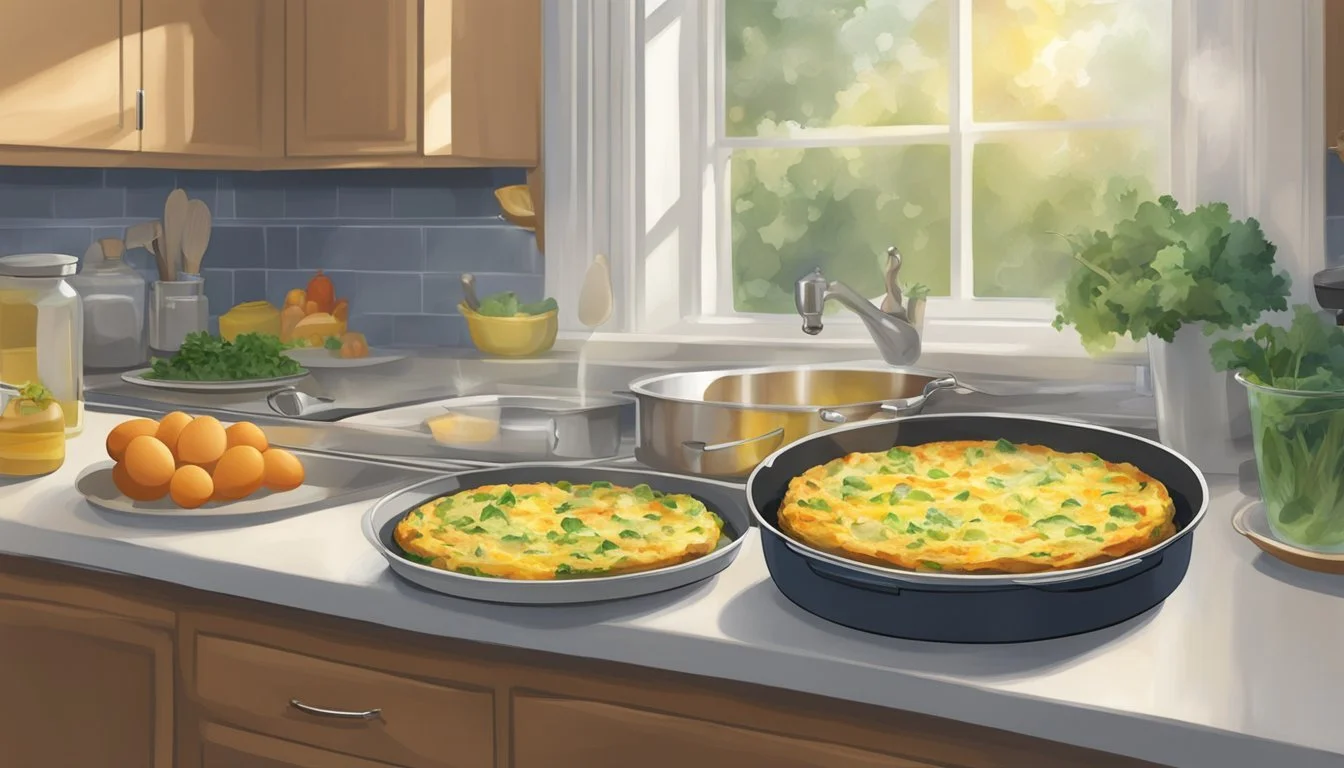How Long Do Freshly Prepared Frittatas Last?
Shelf Life & Storage Tips
Freshly prepared frittatas are a versatile and convenient option for meals throughout the week. They can be enjoyed for breakfast, lunch (What wine goes well with lunch?), or dinner and are often made in advance for meal planning purposes. The shelf life of a frittata in the refrigerator is a common concern for those who like to prepare their meals ahead of time.
When stored correctly, a frittata will stay fresh in the refrigerator for 3 to 4 days. To preserve its quality, it should be kept at a consistent temperature of 40° F or lower. The use of an airtight container is crucial for maintaining freshness and preventing the absorption of odors from other foods. To further ensure quality and safety, containers should be labeled with the date of preparation before storing.
Understanding Frittatas
A frittata is an Italian egg-based dish similar to an omelette or a crustless quiche, (What wine goes well with quiche?) incorporating ingredients such as cheese, vegetables, and meats. Traditionally, it's started on the stovetop in a skillet and often finished in the oven to ensure a firm yet fluffy texture.
Ingredients & Cooking Methods
Eggs: The base of any frittata, providing structure and flavor.
Cheese: Adds richness and can vary from sharp cheddar to creamy goat cheese.
Heat: Essential for cooking, with a medium heat on the stovetop effective for initial cooking.
Oven: Finishing a frittata in the oven helps it to cook evenly and obtain a golden-brown top.
Skillet: A heavy, oven-safe skillet is the preferred pan for making a frittata.
Versatility
Meals: Frittatas are versatile, suitable for breakfast, lunch, or dinner.
Recipes: There are countless recipes available for frittatas, each with unique ingredients and flavors.
Preparation
Begin with beating the eggs, then mix in milk or cream, along with salt and pepper.
Sauté chosen ingredients in the skillet before pouring in the egg mixture.
Cook over medium heat until the edges begin to set, then transfer the skillet to the oven if desired.
This dish is not just for breakfast; it's a beloved option for any meal, celebrated for its simplicity and adaptability.
Key Ingredients for Texture and Flavor
Creating the perfect frittata requires a careful balance of ingredients that contribute to its texture and flavor. This section breaks down the key components, ensuring a delicious and satisfying result.
Selecting the Right Eggs
The foundation of every frittata is eggs, with their yolks adding richness and the whites contributing to a fluffy texture. Use fresh, high-quality eggs for the best results.
Choosing Cheeses and Dairy
Dairy choices, such as milk, heavy cream, or yogurt, influence the frittata's creaminess. Cheeses like feta, mozzarella, and ricotta add depth and flavor.
Incorporating Vegetables
Vegetables such as spinach, tomatoes, and onions must be fresh. Cooked vegetables (how long do cooked vegetables last?) such as roasted red peppers or caramelized onions can add sweetness and complexity.
Meats and Additional Proteins
Adding meats like crisp bacon, Italian sausage, or smoked salmon provides both protein and savory notes. Ensure meats are cooked properly before incorporating them.
Finishing with Herbs and Spices
Herbs like basil and dill (how long does dill last?), and spices such as garlic, black pepper, and salt should be selected for their freshness to elevate the frittata's overall flavor profile.
Frittata Add-Ins for Creativity
Be creative with add-ins such as pesto, salsa, or hot sauce to introduce new flavors. Integrate these elements sparingly to avoid overpowering the main ingredients.
Choosing a Good Frittata Pan
A cast-iron or oven-safe nonstick skillet is ideal for achieving a custardy interior and a lightly browned surface. A pan that transfers well from stovetop to oven is crucial.
Perfecting the Frittata's Consistency
To attain that custardy, fluffy consistency, balance the ratio of eggs to other ingredients and avoid overcooking, which can lead to dryness.
Seasoning and Flavor Balancing
Season with salt and black pepper judiciously to enhance, not overpower, the natural flavors of the eggs, cheese, and produce.
Pre-Cooking Certain Ingredients
Pre-cook items like potatoes or sausage to ensure they are fully cooked and add texture. Sauté vegetables to release moisture and concentrate flavor.
Proper Mixing Technique
Whisk the eggs until the yolks and whites are thoroughly blended. Properly mixed eggs lead to an even, fluffy texture.
Determining the Right Frittata Size
The frittata's size should match the recipe and yield expected. A too-thick frittata will not cook evenly, while too thin will dry out quickly.
Baking and Cooking Methodology
An oven set to the right temperature ensures the frittata cooks gently and evenly, while a stovetop method requires careful temperature control.
Frittata Variations
Experiment with different ingredients to create variations like quiche or a vegetable-heavy option, catering to diverse tastes and dietary needs.
Storing Freshly Prepared Frittatas
Freshly made frittatas can be stored in the fridge for 3 to 4 days. For optimal freshness, ensure the frittata is properly refrigerated in an airtight container.
Reheating and Serving Leftovers
Leftover frittata should be reheated gently in an oven or microwave to maintain its texture and flavor. Do not overheat as this can dry out the frittata.
Shelf Life and Food Safety Considerations
To ensure food safety, consume refrigerated frittatas within the recommended timeframe. Proper refrigeration techniques are key to extending the shelf life of leftovers.




